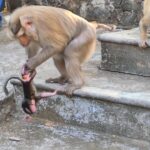In the heart of the African wilderness, beneath the shade of towering acacia trees and amidst the chatter of a bustling troop, a remarkable event takes place—a joyful arrival that breathes new life into the wild. A mother baboon, after hours of labor, successfully gives birth to a healthy baby. The scene is one of triumph, resilience, and deep maternal instinct, celebrated not only by the mother herself but by the surrounding members of her troop.
The birthing process in the wild is never easy. It demands strength, endurance, and an unwavering will to survive. The mother baboon, her body tense yet focused, endures each contraction with determination. Her eyes dart around occasionally, alert to the potential dangers that lurk in the unpredictable wilderness, but she remains primarily concentrated on the task at hand—the safe delivery of her baby.
Finally, after a period of intense effort, the moment arrives. The tiny, wet infant slips into the world, fragile yet full of life. The mother reaches down immediately, her experienced hands gently lifting her newborn. Her face softens, and an expression of relief and overwhelming love spreads across her features. She instinctively begins to clean her baby, using her fingers and mouth to wipe away the afterbirth and stimulate the infant’s first breaths.

The baby, though small and vulnerable, is strong. It lets out its first squeaks, tiny sounds that echo faintly through the trees, announcing its presence to the world. As the mother continues to groom and comfort her newborn, the baby’s tiny hands instinctively grasp at her fur, seeking warmth and security.
Around them, the troop becomes aware of the new arrival. Other female baboons approach cautiously, eyes filled with curiosity and quiet admiration. For baboons, the birth of a new member is a communal event—an addition to their closely knit social structure. Some of the older females, possibly relatives of the mother, may softly grunt or reach out to offer gentle touches, acknowledging both the mother’s accomplishment and the baby’s arrival.
The mother, however, remains protective. She cradles her newborn close to her chest, ensuring that the infant feels her steady heartbeat and the comfort of her body. Her watchful eyes scan her surroundings, keeping a protective barrier between her baby and any potential threat. In this moment, her sole focus is the safety and well-being of her child.
The sun filters through the leaves, casting a warm, golden glow over the scene. The new life nestled in the mother’s arms symbolizes hope and continuity—the perpetuation of the troop’s lineage and the ongoing rhythm of life in the wild. The successful birth is a testament to nature’s resilience, the unbreakable bond between mother and child, and the raw beauty of life’s most primal moments.
As the day progresses, the troop resumes its activities—grooming, foraging, and playing—but the presence of the newborn adds a special kind of joy. For the mother baboon, her journey has just begun, filled with the challenges and joys of raising her baby in the wild. Yet, in this moment, under the vast African sky, she radiates strength, love, and an unmistakable sense of triumph.

